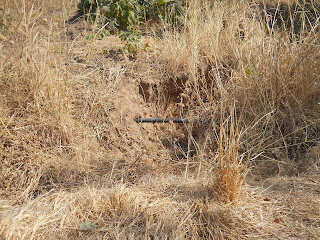Mahove water....one year later
One year ago, Shepherd of the Valley and Tungamalenga Parish celebrated together the precious gift of water arriving at the village of Mahove. What a miracle it was! Lives of the village girls and women changed overnight -- from hours of daily trips four kilometers to the nearest water tap to having water just a few steps from your own house. It was truly cause for celebration.
This year, we visited Mahove and fulfilled a promise we made last year -- that we would walk the 6.8 km pipeline from the juncture at Kitalingolo, where the pipe attached to the existing system's main line, through the village of Mahuninga, through cornfields and backyards, to the bridge and then up the hill to Mahove village, where the line continued around the village with taps or spigots at six locations.
We had walked most of that pipeline a year ago to inspect the work completed, and found the system in good working order. We wanted to see how things had been maintained after the first year.
The pipeline is PVC buried about a meter underground, ideally. At Kitalingolo and other major junctures, concrete boxes like the above protect the joints. It takes a couple strong men to lift the concrete covers.
This valve controls the flow of water. One problem is that anyone strong enough to lift the cover can also adjust the water flow. The day we walked the pipeline, the plumber decided to remove the blue thing that looks like a steering wheel. He adjusted the valve with his wrench (a tool that not many other people own or have access to) in hopes that the flow would be left alone.
We followed the plumber through backyards and cornfields.
For the first few kilometers, the pipeline seemed very well maintained. There were a few small leaks, just a patch of damp ground. The pipeline was buried and no evidence of erosion to expose or damage the pipe.
Then we approached the bridge just outside of Mahuninga.
The pipeline is buried along the side of the road. All of a sudden, about 20 meters before the bridge, you can see there was a major washout -- the pipe is exposed about three feet above the current soil line. The people of the village understand that exposure to sun is not good for the pipe, so they have covered it in some places with brush and fallen trees.
The next challenge comes at the juncture of pipes just before the bridge. There is a leak, as you can see above. We heard a couple different stories about the leak -- was it vandalism, was it kids playing around, was the damage done so that people who live nearby could access the water?
The cover is moved aside to allow for the overflow to run off.
We continue hiking uphill toward Mahove, and count about eleven spots like this. Leaks at the junctures of the pipe. The plumber is paid by the village water committee to fix these leaks, and he cautions that the villagers have to report problems in a timely manner so that problems can be fixed before they get too large.
The closer we get to Mahove, the more people we have joining us for our inspection walk. At the top of the hill, the tap outside the church is flowing strong, with cool and refreshing water.
Mama Petro tells us that the water system is working "no problem! hakuna matata!"
Well, hakuna matata except for two small things. One problem is at the Kanayaa family tap, where the spigot handles have broken off. Water gushes upward in a fountain unless the valve to the side is shut off. The plumber could fix this, if he had a tool to rethread the pipe fittings.
Then there's the "tembo tap." Tembo is the Swahili word for elephant. The last spigot in the water line was planned to water the cattle. There was a simple pipe, verticle, without the cement circle of the other taps.
One night, an elephant came by and knocked over the tap. The pipe remains, partially blocked by a rock, but still trickling a flow of water for the cattle to drink.
This will need to be fixed....perhaps a watering trough for cattle would be a wise investment, perhaps a different kind of spigot, partially hidden under a concrete cover, perhaps a tank...
We had a wonderful conversation with the people of Mahove, discussing what has worked well and what challenges still need addressing. There could be better communication between the village and the water committee which oversees the line for a half dozen villages. There could be better monitoring of some parts of the pipeline, and there could be swifter reporting of problems.
We offer to have St. Paul Partners come out again for a follow up meeting to help them work through some of these issues, and to advise solutions for the problems at the bridge, the Kanayaa tap, and the tembo tap. The people of Mahove responded enthusiastically to that offer.
Two days later, our whole group repeated the walk from the bridge to the village.
Scott, one of our travelers (left), was able to offer advice based on his experiences with water pipelines on a Montana ranch, and his experience as a city utilities manager.
Already, some of the worst leaks had been repaired by the plumber. In other places where erosion had exposed pipes, the villagers had covered the pipes with soil and brush.
It will take constant vigilance and regular monitoring to keep the system in good working order, and the people of Mahove are up to that task.
Thanks be to God for the miracle of clean, accessible water!
.jpg)

















Comments
Post a Comment